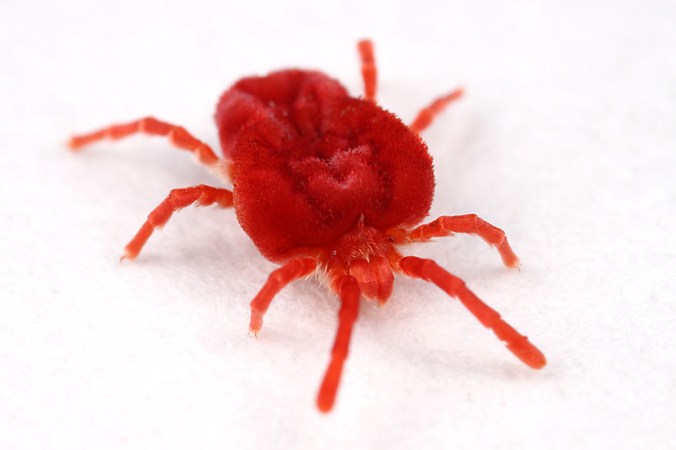I found this velvet mite at Shaw Nature Reserve (Franklin Co.) in east-central Missouri on a trail through mesic upland forest. At 4 mm in length, this member of the superfamily Trombidioidea is a downright honker compared to most other mites. I suspect it belongs to the nominate family, but comments at BugGuide suggest a lateral view of the palps are necessary for a conclusive ID to family. Regardless of its identity, its screaming red color made it ideally suited to be photographed on a white background. On the other hand, its small size and refusal to ever stop crawling made it a frustrating subject to track through a 65mm lens (all photos shown uncropped).
- Comment
- Reblog
-
Subscribe
Subscribed
Already have a WordPress.com account? Log in now.



Aren’t the palps pretty lateral in the downmost picture? Great shots of a difficult subject!
Maybe, but darned if I know what to do with the view.
Thanks!
hi ted! fantastic photo! or shall I say, “Art!”
Thanks Amber, and welcome back.
Great shots! They are tiny, but stand out so well on the forest floor. These photographs make them look like a large soft toy 😀
Thanks Ani. I was also thinking they reminded me of stuffed toys when I first saw the photos on the computer.
They look like fluffy pillows!
😀
It looks kind of deflated. Do they puff up when they get hold of a good meal?
Good question – from what I gather most species overwinter as adults and lay eggs in the spring, so maybe they’re plump in the fall and shrivel up as they use energy over the winter. On the other hand, maybe differences in sculpturing are normal inter- or intraspecific variation.
Great photos of a difficult subject.
Thank you Marvin!
You sure this isn’t one of your daughters’ plush toys?

These have to be the cutest arachnids of all, though the baby salticid that’s been making the rounds lately is right up there, too:
That baby salticid picture seems to have gone viral!
LOVE velvet mites! Great shots of them! You capture their pure adorableness perfectly. 🙂
Thanks DFW!
Whoa- those are *uncropped*? That thing must be huge!
It’s the biggest one I’ve ever seen, although I understand some species in the superfamily reach a full cm in length. Still, I had the lens at ~3X for these photos.
I think 16 mm is the record – only ticks are bigger in the Acari.
Beautiful shot.
Seriously? A 16mm mite? Sounds dreadfully impressive!
I was finding little florescent-orange/red specks in my dung beetle traps, and thought they were dried flakes from the orange surveyor flags I use to mark the traps. Finally picked out a few, and put them under the scope. VERY cool mites!!!!
I’ve seen presumably phoretic mites commonly on dung/carrion beetles – I wonder if that’s what you’ve gotten.
Ted, These were not actually ATTACHED to the beetles. I just found them in the traps ALONGSIDE the beetles.
Yes – I’m wondering if they were brought in as phoretics and became disassociated in the traps.
Wow! I know how hard these guys are to photograph. Your shots turned out much better than my first attempt. Very nice. 🙂
Thanks, Adrian – honestly I took many many more shots and tossed all but these three. Sometimes it’s just a numbers game.
This guy is indeed from the nominate family Trombidiidae. In answer to a previous question, I’ve found they swell up more due to water than food… but a proper diet, water, and whether the specimen is gravid all contribute to the fullness of a specimen. Nice photos!
Cool – thanks for the ID confirmation and extra info.
Hi, I sell Zootermopsis Angusticollis in a home desktop habitat. I have questions about the mites that I am observing in my colonies. I would love to get info on how to identify these species. Could you give a hand?
Best,
chris Poehlmann
Fascinating photo!
Thanks, WS – and welcome!
I am amazed to come across the picture of these beautiful mite. I lived in Goa India about 25 yrs ago and I remember seeing these mites. As a child I saw these mites come out during the early monsoon. I used to collect them and line them up for a race (kids stuff) keep in mind there were no electronic. The soft velvet coat and the bright red color always fascinated me.